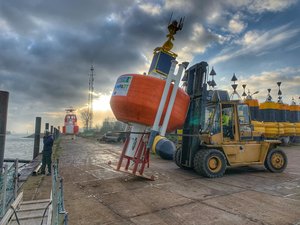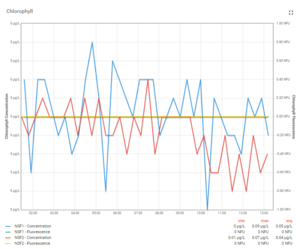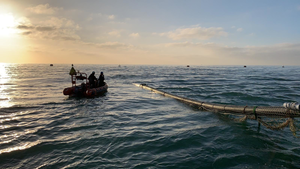First IMTA-pilot on the North Sea
2020-02-07
Ready? Set. Go! The first North Sea Mussel Module is now treading water! Water that is, from now on, being measured by our brand new NSIL Data Buoy. Yesterday, around noon, we headed off to the North Innovation Lab to install the NSIL Data Buoy and a mussel module. By placing the latter directly next to the already operational seaweed module, SMAC3.0, we are taking an important first step towards testing integrated aquaculture at our offshore lab. The measurement buoy will help in measuring the effects of such an integrated setup and we’re very happy to see that as of its launch yesterday it is successfully measuring various sea water parameters and sending them directly to an onshore monitoring station. The Data Buoy and Mussel Module are part of the European project IMPAQT; the design and installation were carried out in close collaboration with Proeftuin op de Noordzee and Rijkswaterstaat.
Aquaculture data for sea farmers
It’s Thursday morning, the 6th of February, 7.30 am. A rising sun greets the Data Buoy and Mussel Module at Rozenburg; the place from where we’ll head off to the North Sea Innovation Lab to install both buoy and module in our beautiful and sometimes rough sea. The crew of the MS Terschelling is busy hoisting the Mussel Module on board.
The Mussel Module is a pilot as part of the European IMPAQT project. The pilot focusses on testing an Integrated Multi-Trophic Aquaculture setup at the North Sea Innovation Lab, in which various forms of aquaculture – in this case seaweed and shellfish cultivation – are combined. The idea behind this is that both systems will benefit from each other’s presence. Therefore, the Mussel Module was put close to our SMAC3.0 seaweed module, that was installed in November last year.
Buoy for sea data
The Mussel Module was not alone: we also launched our a newly developed NSIL Data Buoy. The purpose of the Data Buoy is to generate datasets comprising various important parameters, such as turbidity, salinity, tidal current speeds, Chlorophyll-A and temperature. Most sensors are connected via a local offshore wireless network to an internet connected modem called DAS. The DAS will send the data directly to an online dashboard in which the real time data is being displayed. As you can imagine, this real time monitoring of the sea is extremely useful for better insights into offshore food production and ecosystem services of integrated aquaculture. You can already imagine future sea farmers checking the condition of their seaweed from behind their computers. Their farm is just one click away!
Friday morning, 9.00 am: a quick log-in shows us that the NSIL Data Buoy is measuring a sea water temperature of 7 degrees. Which means: it works! The sensors work, the internet connection works and the dashboard works; we receive several datasets on all parameters mentioned above. In other words: we can monitor in real time the conditions at the North Sea Innovation Lab and the conditions directly in between the SMAC3.0 seaweed module and the newly installed Mussel Module. A mini-IMTA at the North Sea has now become a reality!
Next steps
The next step in this project is to share the measurements of the buoy in an online data cloud – part of the IMPAQT project – to support open access of these measurements. We are curious to see how our newly installed machinery will handle the upcoming storm of Sunday. However, both NSIL Data Buoy and Mussel Module were built to last, so we hope all goes well. Stay tuned, we’ll keep you updated as soon as we have news to share.
More info on the Data Buoy via our project page or visit the IMPAQT project page.


